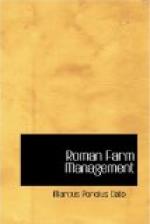Of the four kinds of propagation which I have discussed, that of graftage is preferred in respect of those trees which, like the fig, are slow in developing: for the natural seeds of the fig are those grains seen in the fruit we eat and are so small as scarcely to be capable of sprouting the slenderest shoots. For all seeds which are small and hard are slow in germinating, while those which are soft are more spontaneous, just as girls grow faster than boys. Thus by reason of their feminine tenderness the fig, the pomegranate and the vine are quicker to mature than the palm, the cypress and the olive, which are rather dry than humid by nature. Wherefore we some times propagate figs in nurseries from cuttings rather than attempt to raise them from seed: unless there is no other way to secure them, as happens when one wishes to send or receive seed across the sea. For this purpose the ripe figs which we eat are strung together and when they have dried out are packed and shipped wheresoever we wish, and thereafter being planted in a nursery they germinate. In this way the Chian, the Chalcidian, the Lydian, the African and other foreign varieties of figs were imported into Italy.
For the same reason olives are usually propagated in nurseries from truncheons such as I have described, rather than from its seed, which is hard like a nut and slow to germinate.
Of seeding alfalfa
XLII. You should take care not to plant alfalfa[93] in soil which is either too dry or half wet,[94] but in good order. The authorities say that if the soil is in proper condition a modius (peck) and a half of alfalfa seed will suffice to sow a jugerum of land. This seed is sowed broad-cast on the land like grass and grain.
Of seeding clover and cabbage
XLIII. Snail clover (cytisus) and cabbage is sowed in beds well prepared and is transplanted from them and set out so that the plants are a foot and a half apart, also cuttings are taken from the stronger plants and set out like those which were raised from seed.




